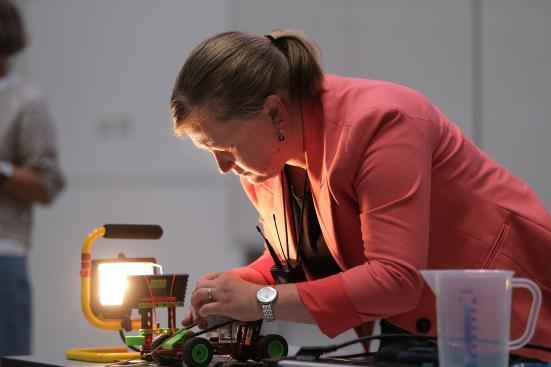Cars can run on hydrogen

Hydrogen is the most abundant element in the universe, a colorless, odorless and tasteless gas that occurs on Earth mainly in compounds such as water. It is an energy carrier that can be used to store, transport and supply energy, for example as a fuel for vehicles or as a raw material in industry. Energy is required to produce hydrogen, and if this is obtained from renewable sources, it is referred to as "green hydrogen", which is climate-neutral.
So much for the search engine's answer. Prof. Anna Katharina Beine (Energy Process Engineering) explained the question "What is hydrogen? And can cars run on it?". The lecturer had an H2 Fuel Cell Car with a fuel cell and solar system. First, hydrogen and oxygen are converted into electrolysis when energy is supplied (here: solar panel or socket), the gases are stored in the tank and can then be converted back into water by the fuel cell. The children also got an impression of this with the balloon experiment. A balloon filled with hydrogen, to which a lighted sparkler is held, bursts noisily. The energy released is discharged in a bang.
But back to the beginning of the event. Anna Katharina Beine showed the eight to twelve-year-olds the periodic table of the elements. In first place is hydrogen with the abbreviation H. Elements can occur in three states of aggregation: solid, liquid and gaseous. Solid elements include carbon (C), aluminum (Al), gold (Au) and iron (Fe). Mercury (Hg) is liquid and oxygen (O) is gaseous. Nitrogen (N) becomes liquid at - 196 degrees. The scientist used special equipment to demonstrate this to the children.
Hydrogen is also a gas. Hydrogen can be used as an energy carrier and energy storage medium - just like coal, natural gas, wind, wood, petrol or crude oil. Primary energy sources such as natural gas, wood, solar radiation or wind are natural forms of energy. Secondary energy sources such as hydrogen must first be produced from natural energies.
In order to stop the greenhouse effect and thus climate change, CO2 emissions on earth must be reduced. Anna Katharina Beine: "That's why we need sustainable energy sources". Hydrogen is an energy-rich gas. Its calorific value is 33,861 kilocalories per kilogram. This is roughly equivalent to the energy of 7 kilograms of chocolate. How can we harness this energy? By burning hydrogen in oxygen, for example. This produces water and releases energy - see the balloon experiment described above. This corresponds to the principle of fuel cells. The stored hydrogen can be used to generate energy at night with the help of a fuel cell when the sun is not shining and the wind is generally less strong. Since only water is produced as a "waste product", hydrogen is an environmentally friendly energy source. However, hydrogen cars are currently still expensive as their market share is low and the technology is still being developed. After the lecture, the children at the children's university had lots of questions....
